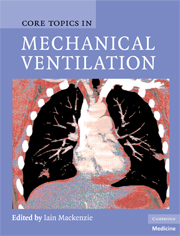Book contents
- Frontmatter
- Contents
- Contributors
- Foreword
- Preface
- Introductory Notes
- 1 Physiology of ventilation and gas exchange
- 2 Assessing the need for ventilatory support
- 3 Oxygen therapy, continuous positive airway pressure and non-invasive ventilation
- 4 Management of the artificial airway
- 5 Modes of mechanical ventilation
- 6 Oxygenation
- 7 Carbon dioxide balance
- 8 Sedation, paralysis and analgesia
- 9 Nutrition in the mechanically ventilated patient
- 10 Mechanical ventilation in asthma and chronic obstructive pulmonary disease
- 11 Mechanical ventilation in patients with blast, burn and chest trauma injuries
- 12 Ventilatory support: extreme solutions
- 13 Heliox in airway obstruction and mechanical ventilation
- 14 Adverse effects and complications of mechanical ventilation
- 15 Mechanical ventilation for transport
- 16 Special considerations in infants and children
- 17 Tracheostomy
- 18 Weaning, extubation and de-cannulation
- 19 Long-term ventilatory support
- 20 The history of mechanical ventilation
- Glossary
- Index
Foreword
Published online by Cambridge University Press: 14 October 2009
- Frontmatter
- Contents
- Contributors
- Foreword
- Preface
- Introductory Notes
- 1 Physiology of ventilation and gas exchange
- 2 Assessing the need for ventilatory support
- 3 Oxygen therapy, continuous positive airway pressure and non-invasive ventilation
- 4 Management of the artificial airway
- 5 Modes of mechanical ventilation
- 6 Oxygenation
- 7 Carbon dioxide balance
- 8 Sedation, paralysis and analgesia
- 9 Nutrition in the mechanically ventilated patient
- 10 Mechanical ventilation in asthma and chronic obstructive pulmonary disease
- 11 Mechanical ventilation in patients with blast, burn and chest trauma injuries
- 12 Ventilatory support: extreme solutions
- 13 Heliox in airway obstruction and mechanical ventilation
- 14 Adverse effects and complications of mechanical ventilation
- 15 Mechanical ventilation for transport
- 16 Special considerations in infants and children
- 17 Tracheostomy
- 18 Weaning, extubation and de-cannulation
- 19 Long-term ventilatory support
- 20 The history of mechanical ventilation
- Glossary
- Index
Summary
Bjorn Ibsen, an anaesthetist and intensivist who practiced for most of his career in Copenhagen, Denmark, died on 7 August 2007. Ibsen is widely regarded as the father of Intensive Care Medicine, the nativity of which occurred in his home city in 1952 during a polio epidemic. Ibsen had trained in radiology, surgery, pathology and gynaecology before travelling to Massachusetts General Hospital in 1949 to gain specialist experience in anaesthesia. He returned to Copenhagen in 1950 and assumed a leading role in managing one of the world's worst polio epidemics that started only two years later. Some 2899 cases developed among the population of two million. Too weak to cough, many patients succumbed to secretion retention with associated carbon dioxide retention. Negative pressure ventilation was effectively the only form of support then available, but Ibsen found that tracheostomy, or endotracheal intubation combined with the careful application of intermittent positive pressure ventilation administered by relays of doctors, medical students and others, was an effective means of over-coming the devastating effects of the disease. In the end, over 1500 practitioners aspirated secretions and performed manual ventilation in shifts. Mortality fell markedly. As a result, the idea that critically ill patients should be supported in centralized facilities by individuals experienced in their care was adopted worldwide.
- Type
- Chapter
- Information
- Core Topics in Mechanical Ventilation , pp. ix - xPublisher: Cambridge University PressPrint publication year: 2008

